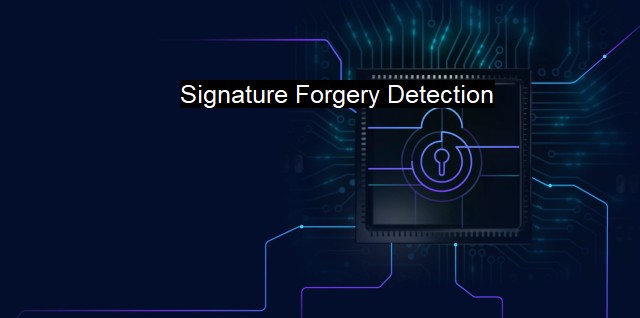What is Signature Forgery Detection?
Ensuring Electronic Document Authenticity: The Importance of Signature Forgery Detection in Cybersecurity
Signature forgery detection is essentially a process designed to primarily authenticate and verify signature patterns while detecting any occurring anomalies that could signify a forgery - it's perceiving legitimate or fraudulent activities of signature patterns to ensure security. Historically, it was carried out personally by human eyes, particularly in banking and legal sectors, to authenticate written signatures on documents. In modern times we increasingly witness signature forgery detection being put into the context of cybersecurity, as more and more digital activity takes front and center stage across multiple sectors.Signature forgery detection places emphasis on the art of differentiating an original digital signature from counterfeit signatures. It revolves around identifying unauthorized modifications to digital signatures, which are critical elements for ensuring data integrity and non-repudiation across the cyber domain. Not to be mistaken with simply handwriting verification, such signature forgery detection expands to algorithm-based technologies for identifying and responding to these unauthorized actions. Such unauthorized actions often take the form of malicious activities targeted against information or systems in the network.
Digital signatures work as mathematical algorithms that create a uniquely identifiable signature, providing a proof of authenticity for a particular document or data piece. Fundamentally inseparable from its host data, a digital signature’s duty is not only to identify forged signatures but also to deter individuals from even attempting forgery. Cyber signature forgery, thus, gets highlighted as an earnest issue which demands proper detection and thorough attention lest undermining critical security measures that potentially lead to huge losses, both material and immaterial.
In cybersecurity and antivirus landscape, signature forgery detection gets incorporated into multiple strategies and structures. One being an antivirus software which essentially employs signature-based detection, among

Signature Forgery Detection FAQs
What is signature forgery detection, and how does it help with cybersecurity?
Signature forgery detection is a technique used in cybersecurity to detect when a malicious actor is attempting to impersonate a legitimate user or application. It involves analyzing the digital signature of a file or message to ensure that it has not been tampered with or modified in any way. By detecting and preventing signature forgery, cybersecurity professionals can protect their systems and data from a variety of threats, including malware, viruses, and other types of cyberattacks.What are some common methods used for signature forgery detection?
There are several methods used for signature forgery detection, including pattern recognition, machine learning, and cryptographic techniques. Pattern recognition involves scanning files or messages for certain signatures or characteristics that are known to be associated with legitimate users or applications. Machine learning uses algorithms and statistical models to identify patterns and anomalies in digital signatures, while cryptographic techniques rely on mathematical algorithms to generate and verify signatures. Each method has its strengths and weaknesses and can be used in combination for added security.Can antivirus software detect signature forgery?
Yes, most modern antivirus software includes signature forgery detection as part of its overall security suite. Antivirus software may use a combination of techniques to detect and prevent signature forgery, including scanning files for known malware signatures, monitoring network traffic for suspicious activity, and analyzing the behavior of running applications for signs of malicious activity. In addition, antivirus software can also provide real-time protection against zero-day attacks and other emerging threats by using machine learning and other advanced techniques to predict and prevent attacks before they occur.What are some best practices for preventing signature forgery in cybersecurity?
To prevent signature forgery in cybersecurity, it is essential to implement a comprehensive security strategy that includes both technology and best practices. This may include using strong encryption and authentication protocols, enforcing strict access controls, and regularly updating software and security patches. Other best practices may include training employees on the risks of cyber threats, conducting regular security assessments and audits, and implementing a proactive incident response plan to quickly address and mitigate any security breaches that occur. By taking a holistic approach to cybersecurity, organizations can minimize the risk of signature forgery and other types of cyber threats, ensuring the safety and integrity of their data and systems.| | A | | | B | | | C | | | D | | | E | | | F | | | G | | | H | | | I | | | J | | | K | | | L | | | M | |
| | N | | | O | | | P | | | Q | | | R | | | S | | | T | | | U | | | V | | | W | | | X | | | Y | | | Z | |
| | 1 | | | 2 | | | 3 | | | 4 | | | 7 | | | 8 | | |||||||